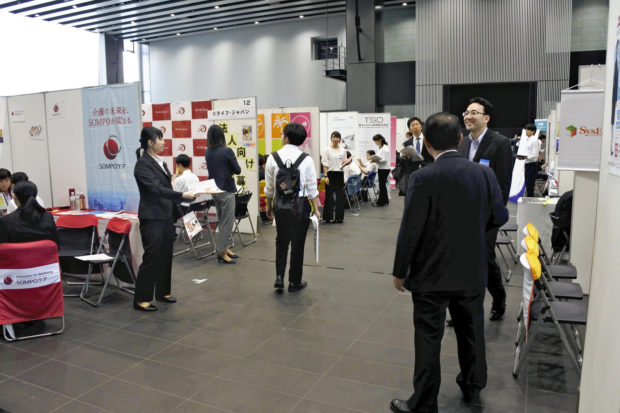
The Japan News/Asia News Network
TOKYO — Students are at an advantage in this year’s job market, but a number of female students are still struggling to get an informal job offer and number of women without job offers is higher than last year.
The trend has apparently emerged because of efforts mainly within the financial industry to curb the number of new recruits for so-called general career tracks ― secretarial and office work positions that many women take up. With the job-hunting season nearing an end, female students searching for employment are growing concerned.
According to Recruit Career Co., 78.8 percent of female university students had received informal job offers as of July 1, down 2.7 percentage points from the previous year. However, since the start of companies’ recruitment activities on June 1, 84.4 percent of male students had received such offers, up 7.2 points and the highest figure for the past three years.
A female senior at a private university who attended a joint company information session in Tokyo in mid-July said: “Many of my male classmates had secured a job by June. I’m really frustrated now.”
The trend owes a lot to the massive cutbacks in general career track positions. In the financial industry, several leading banks will largely reduce the number of these recruits by several hundred from the previous year, while a similar move is being seen at regional banks, and securities and insurance companies.
Causes of the cutbacks are a deterioration in the earning environment ― triggered by low interest rates ― and the introduction of artificial intelligence for future operations.
General career track positions in the finance industry are still popular among female students. As the positions became competitive because of fewer people being hired, it seems the job offer rate for female students also decreased.
The trend of men being hired more and women being hired less has often been evident during tight economic times, when companies reduce the number of people being hired.
During the “employment ice age” around 2000 and the period following the collapse of Lehman Brothers in 2008, the percentage of female students who got job offers was between five and 10 points lower than that of male students.
The Japan News/Asia News Network
Over the past few years, however, female students have been more actively employed due to the declining birth rate and a lack of manpower, narrowing the percentage gap between men and women.
Among those who graduated in the spring of 2017, the job offer rate for women was 0.4 points lower than for men as of July 1 that year, while for those who graduated in the spring of 2018, the rate for women was 4.3 points higher than that for men.
At the beginning of the job-hunting season for 2019 graduates, the seller’s market trend had become prominent, so the job offer rate for female students was expected to rise even higher. However, the actual job market has been buffeted by changes in companies’ recruitment policies.
“Students are asked to change their career direction to aspire for a wider range of jobs,” said Zen Masumoto, chief researcher at Recruit Career’s Research Institute for Graduate Recruitment.